
by Nina
“Goodnight stars. Goodnight air. Goodnight noises everywhere.” —Margaret Wise Brown, from Goodnight Moon
As anyone who has raised small children surely knows, if you want your child to go to sleep, you can’t just quickly tuck a wide-awake baby or child into bed and then walk away. Instead, most children need a transition time between being fully awake and playing with family members or eating dinner and then falling asleep for the night. And very often using the same “ritual” to get your child to settle down before bedtime is especially effective. So before going to sleep, it’s time to “get ready for bed” by changing into nightclothes, brushing teeth, getting settled in bed with a stuffed animal or two, and then listening to a story read out loud or some lullabies. That’s why the book Goodnight Moon is so popular! My children loved it. (If you’re not familiar with Goodnight Moon, that entire book is a mother bunny putting her child to sleep with a ritual of saying goodnight to all the things the child can see and sense in their room.)
So as adults why would we expect ourselves to be able to drop right into bed after checking our email, watching a suspenseful TV show, or cleaning the kitchen? I know it doesn’t work well for me and I’m guessing it doesn’t work well for most of you, either, especially for those who have sleep problems. This is why, for people who have any kind of sleep problems (trouble falling asleep or trouble staying asleep), I suggest you dedicate some time before you get into bed to “get ready” in the same way you would help a child to get ready. This will help your brain and body move into the right state to allow you to ease into sleep. So even if you’re exhausted and dying to drop into bed, taking your time before you actually get into the bed can pay off by helping to prevent insomnia and providing you with deeper rest.
What you do for your pre-bedtime ritual is up to you. Doing a single relaxing yoga pose or short practice before is an excellent way to prepare for sleep. Some ideas include:
1. 5 to 10-minute seated meditation, preferably yogic concentration meditation, where you focus on your breath, an image, or a mantra, rather than mindfulness meditation. See All Good But Not Equivalent: Meditation Types for a comparison.
2. A short session of a simple, calming seated breath practice, where you do any familiar practice that lengthens your exhalation. See Calming Breath Practices We Recommend for options.
3. A guided or self-guided progressive relaxation practice, where you tense and release various parts of your body or just bring your awareness to various areas and intentionally relax them.
4. Supported Legs Up the Wall pose, either with legs up the wall or the modified version, Easy Inverted pose, with calves resting on a chair seat:
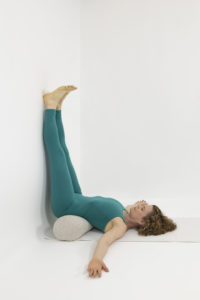
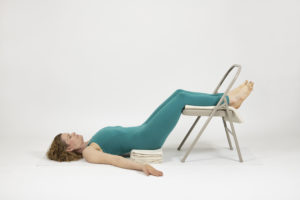
5. Supported Bridge Pose, with bent or straight legs: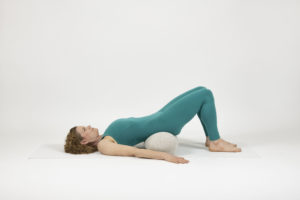
6. Reclined Cobbler’s pose or Reclined Crossed Legs pose:
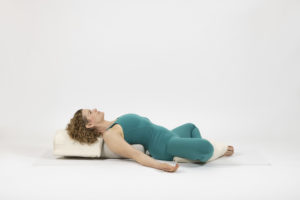
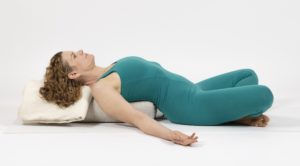
7. Supported Child’s pose: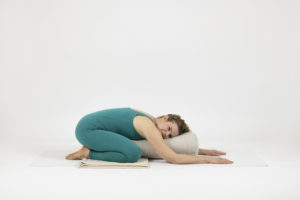
8. Supported Seated Forward Bend with any leg position
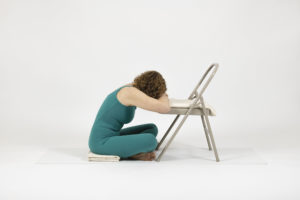
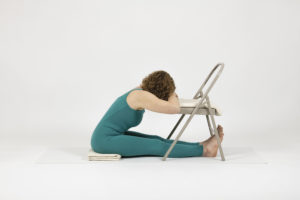
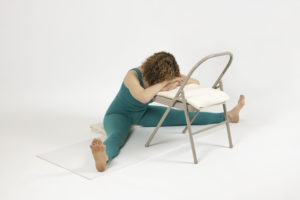
Do whatever you like best! Just stay away from active poses, especially standing poses, backbends, and twists, which tend to be stimulating. Also avoid stimulating breath practices, which include practices that lengthen your inhalation, and probably also balancing practices, where your inhalation and exhalations are the same length.
However, because in my next post I’m going to recommend doing a short yoga practice AFTER you get into bed, your nighttime ritual could consist of other types of activities, such as listening to relaxing music, massaging your feet or moisturizing your face and body, taking a hot bath, scenting your pillow with lavender, and so on. Pick anything that relaxes you and helps you wind down. (Ssshh, I always anoint myself with perfume.)
It is also a good idea to go to bed at the same time every night, if possible. Having a set sleep schedule for going to bed and waking up can condition you to fall asleep more easily. Obviously going to bed at the same time every night isn’t always possible, but you can do your best. In my opinion, getting a good night’s sleep is worth the time and effort you put into it because it makes the rest of your life better.
If you have a nighttime ritual, whether it involves yoga or not, I’d love to hear about it. So leave a comment or drop me a line.
You can find the rest of this series on yoga for better sleep at Better Sleep Tips, Part 2: Putting Yourself to Sleep, Better Sleep Tips, Part 3: It’s the Middle of the Night!, and Better Sleep Tips, Part 4: Day to Night.
Follow Yoga for Healthy Aging on Facebook ° To order Yoga for Healthy Aging: A Guide to Lifelong Well-Being, go to Amazon, Shambhala, Indie Bound or your favorite bookstore or vendor.


My sleep has changed so much during Covid. The routine is a lot less structured. I have gotten in the habit of staying up later to have some alone time.
I always do a forward bend before getting in bed, and my wonderful silk eye mask is amazing. If my thoughts are racing I do a head to toe body scan or focus on mentally describing a process with many steps, such as planning a yoga sequence.